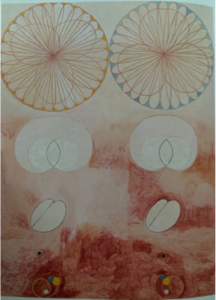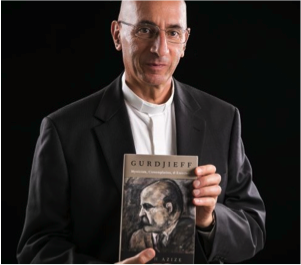“Keep within! And when they say, ‘Look here’ or ‘look there is Christ,’ go not forth….”
 This beautiful gem of Quaker wisdom, set to music by Paulette Meier and well loved by many of you around the Wisdom network, encapsulates both the method and the deeper intention of Gurdjieff’s Atmosphere Exercise. Here we will be actively exploring what it means to “keep within”: not merely as a spiritual demeanor, but as an actual mode of embodied presence. You can listen to the chant here.
This beautiful gem of Quaker wisdom, set to music by Paulette Meier and well loved by many of you around the Wisdom network, encapsulates both the method and the deeper intention of Gurdjieff’s Atmosphere Exercise. Here we will be actively exploring what it means to “keep within”: not merely as a spiritual demeanor, but as an actual mode of embodied presence. You can listen to the chant here.
Call it your “aura,” call it “electromagnetic field of your heart”: the words all point to the same underlying recognition that “we” do not end at the outer edge of our skins. We move within an encompassing energetic field which we ourselves generate, and which—according to Gurdjieff—we are responsible for maintaining in good working order: i.e., unruffled, contained, and under our conscious supervision. He picturesquely refers to this field as our atmosphere.
Contemplative Christianity has also long prized this state of inner containment, which is known in the Christian West as “recollection” and in the Christian East as “vigilance.” It is a state of alert, calm, gathered presence. In its absence, the energy around our being rushes and swirls in an automatic jumble, losing much of its directional force while at the same time negatively entangling itself with other similarly untended atmospheres. The result is an energetic cacophony.
This relatively straightforward exercise will help you to begin to settle down within your own atmosphere, keeping your being-energy contained and quiet under your conscious tending.
As usual, the chief culprit is thinking—or, to be more specific, the completely mechanical and autonomous movement of thinking when we are not consciously present. Gurdjieff says, arrestingly: “Your atmosphere is displaced in the direction in which your thought moves. If you think of your mother who is far away, your atmosphere moves toward the place where your mother is.” To be sure, this speaks of the wondrous, space-traveling capacities of our creative imagination, carried on the wings of our attention: so long as both are under our conscious control. But when imagination becomes infected with nostalgia or fantasy, or is suddenly intoxicated by its own magical powers, then the journey is aborted, and our space traveler falls back under the sway of delusion.
But until you have learned to sense your atmosphere directly, you won’t be able to taste the difference between imagination indentured to fantasy and “the real deal.” It is a tragic trompe l’oeil, on which many sincere aspirations have foundered.
In this exercise we practice remaining within our atmosphere, not letting our thoughts and emotions go ricocheting out beyond the meter to meter-and-a-half circle we imaginatively draw around ourselves. It is the exact inner equivalent of the task we took on one day during our Wisdom School in the desert near Tucson: to draw a six-foot ring around ourselves and sit within it for an hour. We are drawing that same ring—only now in the air, not on the ground. This will be the paddock where we contain the wild horse of our thoughts, emotions, and impulses until the whole thing comes quietly into a wordless equanimity.
In this exercise we meet for the first time Gurdjieff’s unique use of the phrase: “Represent to yourself.” Representing to yourself is not the same thing as visualizing. Close, but not identical. They have subtly different flavors, since they are in fact the work of different centers. Visualizing draws primarily on the intellectual center. Representing remains much closer to sensation. With your attention firmly anchored in your solar plexus (at least that’s how it works for me), you simply allow the radius of your attention to expand outward, to establish a direct sensate contact with the entire sphere of that atmosphere. You will discover that you are able to do this fairly easily if you don’t interfere with the process by thinking.
You may watch how the waves of thinking, emotion, agitation, wash across the still waters of your atmosphere. But if you simply “keep within,” not allowing yourself to be dragged outside its sphere, things will quiet down once again and the depths of a deeper, mysterious aliveness begin to emerge.
 One must also “compel the atmosphere to stay within its limits—not allow it to go further than it can sustain.” That limit is concretely set at a meter to a meter-and-a-half. It actually exists, a palpable energy field. Anything beyond this, and you will likely be venturing out under the sway of thought, emotion, or unanchored visualization. And you will inevitably get tangled up in other people’s atmospheres.
One must also “compel the atmosphere to stay within its limits—not allow it to go further than it can sustain.” That limit is concretely set at a meter to a meter-and-a-half. It actually exists, a palpable energy field. Anything beyond this, and you will likely be venturing out under the sway of thought, emotion, or unanchored visualization. And you will inevitably get tangled up in other people’s atmospheres.
I have often used this sanctuary of my atmosphere to navigate through a rough patch when a group I am teaching begins to get energetically disturbed—i.e., heady, confrontational, or intoxicated with a kind of group musk. Sometimes the only thing that can be done is to plant my attention in my solar plexus, “shelter in place” within my atmosphere, and hold the space until the disturbed waves subside. Mysteriously, this will often have a calming presence on the whole group. I have learned through repeated hard knocks that usually this is the ONLY way to shift the energy. Taking the bait when an inflamed emotional or intellectual challenge has been hurled onto the floor is like pouring gasoline on a fire. Only by standing firm in that stillness will the disturbed atmosphere within the group begin to settle.
And this stands to reason, since the disturbance has been created in the first place by the group leader failing to notice when, carried away by thought, emotion, or passion, the group members have been drawn out of their individual atmospheres. The result will always be trouble.
Learning to stay within one’s own atmosphere is not only responsible self-maintenance; it is also foundational group hygiene. We will see more why this is so when we come to the next exercise: The Web.
*****
NOTE: This series began on March 23, 2020, with the post entitled:
Pandemic Homework.
The series of posts that followed are available at these links:
From the Eagle’s Nest (the background to the instructions)
Foundational Points for the Five Pandemic Homework Exercises
Raised Cyber Eye-Brows: More on Internet Technology and the Pandemic Homework
The posts continue with a series of “Commentaries on Elements of the Exercises,” which began with:
“Clear Impressions”: Part I
“Lord Have Mercy”: Part II, A & B
Connecting the Dots: The “Lord Have Mercy”: Part II, C
“Make Strong! Not Easy Thing: Part III, A & B”
Cynthia says, “I am very grateful to Joseph Azize for his willingness to make five—now six—of the Gurdjieff exercises available to us within the cyber confines of our Wisdom School Community. These exercises are powerful tools of healing, cleansing, and clarity, and even when practiced individually or in small groups, they have a power to significantly shift our present planetary atmosphere. They are something you can actually do: to steady yourself and ready yourself for the deeper energetic work that actually connects us and empowers us as a human species to do the alchemical work we were placed on this planet to do.”
Joseph Azize’s newly published Gurdjieff: Mysticism, Contemplation & Exercises is available now through his website at Under the Sun for a 30% discount from Oxford University Press. All of the Gurdjieff exercises recommended in Cynthia’s Pandemic Homework are in this book, with extensive supporting research and commentary. It is a great resource, and highly recommended.
You may find Paulette’s new CD on her website, Paulette Meier, here.
Images credits, from the top down: Hildegard de Bingen, Blue Christ mandala; Hilma af Klint, Group IV, The Ten Largest, No 9 Old Age, 1907; A Man Enthroned within a Mandorla in a Tree, 1277- 1300; and image courtesy of the website of Joseph Azize



Composed May 27, 2020
We are living in unprecedented times.
Reason for concern is reason to unite “to warm the atmosphere”.
Prior to the Ying Yang post I was, seemingly out of nowhere, considering the reality of the Yin Yang symbol, and questioning the ‘necessity of darkness’ to counterbalance the light (to maintain harmony). Days later I happened upon Hellmut Wilhelm’s book CHANGE. Darkness has many connotations and not all EVIL (my current definition of evil being anything counter to life – evil spelled backwards live).
Excerpts:
page 19 – 20 To recognize that man moves and acts, that he grows and develops, this is not deep insight, but to know that this movement and development takes place in typical forms and that these are governed by the law of change, from which there is no escape, this is the knowledge that has fostered in early Chinese philosophy its gratifying integrity and lucidity.
It is not easy to present in plastic form the development that manifest itself in this way, that is inherent in all phenomena. The concept of change is not an external, normative principle that imprints itself upon phenomena; it is an inner tendency according to which development takes place naturally and spontaneously. Development is not a fate dictated from without to which one must silently submit, but rather a sign showing the direction that the decisions take. Again, development is not a moral law that one is constrained to obey; it is rather the guideline from which one can read off the events. To stand in the stream of this development is a datum of nature; to recognize it, and follow it, is responsibility and free choice.
When this idea of change is applied to the evolution of an individual man, of social groups and of the era, a series of makeshift hypotheses we have been accustomed to use in explaining events falls away. The principle implies no distinction between inside and outside, content and form. It is implanted in a man’s heart; it is active and discernible. In the same way, it is active in human groupings and in whatever is great in the era. This it not only embodies, but carries the “soul” of the group, and the “spirit” of the time. The universality of its power includes all levels in all dimensions; every seed that is planted grows and matures within its scope. (The FIE)
The movement of change thus conceived is never one-dimensional in direction. If we keep to an image, cyclic movement is the best term for it. The later commentary literature has made frequent use of this image, but the rigidity that came about because of it is alien to the book itself. The idea of a movement that returns to its starting point, however, is certainly basic. It may have been derived from the orbits of the heavily bodies or the course of the seasons. To the old Chinese, death itself meant a return. But, in such an interpretation more is implied of the idea of self-containment or wholeness than of recurrence. The notion of progress, which we have incorporated in the idea of cyclic movement by the image of the spiral, is alien to the ancient concept of change. The value judgement contained in our idea does not accord with the image made after nature. And the attempt to exalt the new at the expense of the old, the future at the expense of the past, was alien to Chinese thought. The accent lies solely on the ability to keep within the flow of change. If earlier times have been superior to us in this respect, the fact is recognized without prejudice, and the lesson is drawn that we should feel obliged to do as well as the ancients did.
The fact that the movement returns to its starting point keeps it from dispersing, which movement in one direction cannot prevent. The infinite is thus brought within the confines of the finite, where alone it can be of service to man.
Safety is the clear knowledge of the right stand to be taken, security in the assurance that events are unrolling in the right direction.
Page 21-22
We see that here the concept of change comes very close to the Taoist law of the cosmos, the tao of Lao-tse, the meaning of which is so difficult to convey in another tongue.
The Book of Changes contains the measure of heaven and earth; therefore it enables us to comprehend the tao of heaven and earth and its order…Since in this way man comes to resemble heaven and earth, he is not in conflict with them. His wisdom embraces all things, and his tao brings order into the whole world; therefore he does not err…In it are included the forms and the scope of everything in the heavens and on the earth, so that nothing escapes it. In it all things everywhere are completed, so that none is missing. Therefore, by means of it we can penetrate the tap of day and night, and so understand it. Therefore the spirit is bound to no one place, nor the Book of Changes to any one form.
…the Book of Changes derives the idea of consistency and all-inclusiveness. We see that change is at work in the great as well as in the small, that it can be read in cosmic happenings as well as in the hearts of men. From this comprehensiveness of tao, embracing both macrocosm and microcosm, the Book of Changes derives the idea that man is in the center of events; the individual who is conscious of responsibility is on par with the cosmic forces of heaven and earth. This is what is meant by the idea that change can be influenced. Here again…a passage in the Tao Te Ching containing a similar thought.
In this point of view, which accord the responsible person an influence on the course of things, change ceases to be an insidious, intangible snare and becomes an organic order corresponding to a man’s nature. No small role is thus assigned to man. Within set limits he is not merely master of his own fate, he is also in a position to intervene in the course of events considerable beyond his own sphere. But it is his task to recognize these limits and remain within them. And to further this understanding by putting the experience of olden times and its wise men at his disposal, the Book of Changes was written.
Thoughts triggered in me in reading the gift of your message: The soul incarnates in human form, and remains the essence of the person. It seems to me the soul has a body, not the body that has a soul. The soul extends eternally, though probably only humanly detectable at this time as an energy field extending a few feet around the physical body. What appears to be a cacophony of souls especially in close range is one Soul. Each person is within his or her atmosphere while being part of the cosmos.
This is very good and there are different names for behaving in this manner. The act of mindfulness, responding versus reacting, and maintaining bearing. It is simple but not easy without practice. I taught mindfulness to my fourth graders and believe that if we raise children to acquire equanimity, the world could be changed. A big if, to be sure. Thank you, Cynthia.
“This will be the paddock where we contain the wild horse of our thoughts, emotions, and impulses until the whole thing comes quietly into a wordless equanimityâ€.
The above excerpt reminds me that James Finley once told a story about a young monk raising a water buffalo. He told the story with such inventiveness and humor that it stuck with me. So much so, that over the years I have seen much of my own behavior as that of an immature water buffalo. Hopefully my water buffalo is beginning to stay within its boundaries. Equanimity is a wonderful word for it.
Thank you Cynthia. These blogs are like food for me. Especially as I work with the practices.